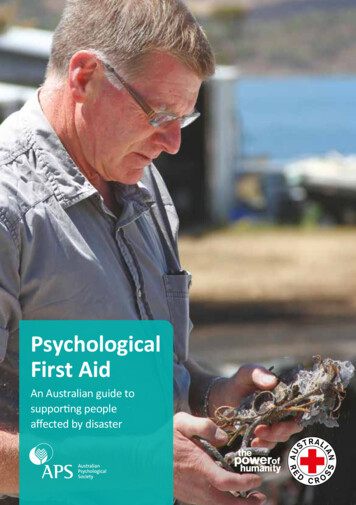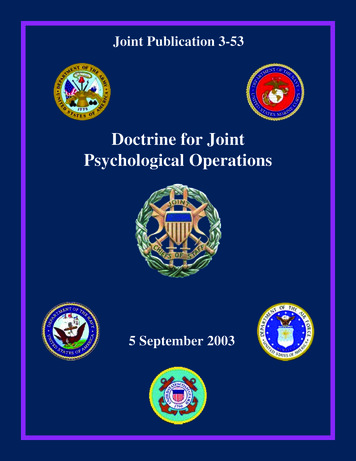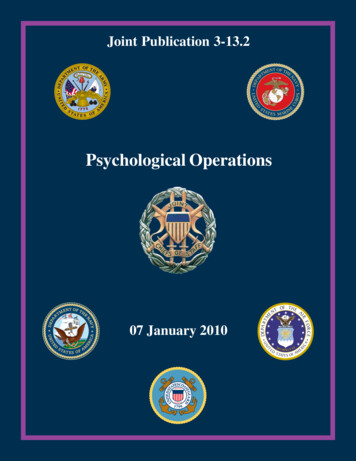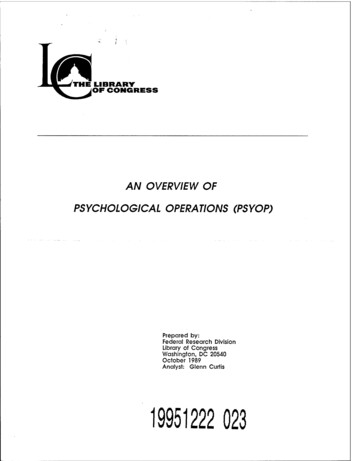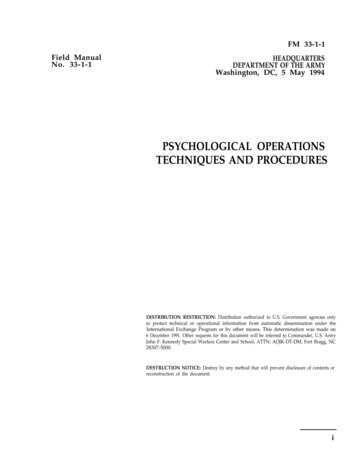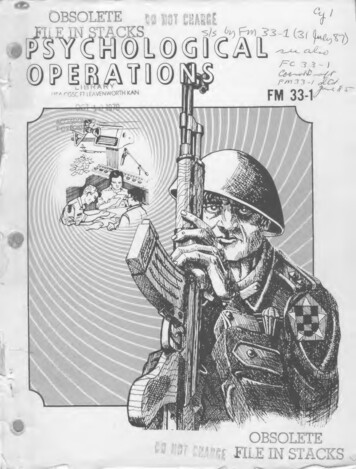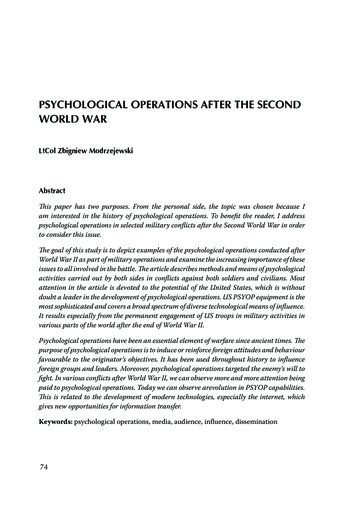
Transcription
Psychological operations after the SecondWorld WarLtCol Zbigniew ModrzejewskiAbstractThis paper has two purposes. From the personal side, the topic was chosen because Iam interested in the history of psychological operations. To benefit the reader, I addresspsychological operations in selected military conflicts after the Second World War in orderto consider this issue.The goal of this study is to depict examples of the psychological operations conducted afterWorld War II as part of military operations and examine the increasing importance of theseissues to all involved in the battle. The article describes methods and means of psychologicalactivities carried out by both sides in conflicts against both soldiers and civilians. Mostattention in the article is devoted to the potential of the United States, which is withoutdoubt a leader in the development of psychological operations. US PSYOP equipment is themost sophisticated and covers a broad spectrum of diverse technological means of influence.It results especially from the permanent engagement of US troops in military activities invarious parts of the world after the end of World War II.Psychological operations have been an essential element of warfare since ancient times. Thepurpose of psychological operations is to induce or reinforce foreign attitudes and behaviourfavourable to the originator’s objectives. It has been used throughout history to influenceforeign groups and leaders. Moreover, psychological operations targeted the enemy’s will tofight. In various conflicts after World War II, we can observe more and more attention beingpaid to psychological operations. Today we can observe arevolution in PSYOP capabilities.This is related to the development of modern technologies, especially the internet, whichgives new opportunities for information transfer.Keywords: psychological operations, media, audience, influence, dissemination74
IntroductionNowadays, we should consider psychological operations as an integral part ofmilitary operations.PSYOP may be conducted in both the long and short term across the full spectrumof military operations . Modern PSYOP are enhanced by the expansion of masscommunication capabilities (Internet, mobile phones, social media etc.).To employ successful PSYOP it is essential to use effective communicationtechniques to convey the message to the target audience. The function of PSYOPis to use communication to influence behaviour .Carl von Clausewitz said “killing the enemy’s courage is as vital as killing his troops” .More of my favourite PSYOP quotes are included below:“To capture the enemy’s entire army is better than to destroy it; to take intact aregiment, a company, or a squad is better than to destroy them. For to win onehundred victories in one hundred battles is not the acme of skill. To subdue theenemy without fighting is the acme of skill”.Sun Tzu (544 B.C.–496 B.C.)“There are but two powers in the world, the sword and the mind. In the long run thesword is always beaten by the mind”.Napoleon Bonaparte (1769–1821)“The real target in war is the mind of the enemy command, not the bodies of histroops. If we operate against his troops it is fundamentally for the effect that actionwill produce on the mind and will of the commander; indeed, the trend of warfareand the development of new weapons – aircraft and tanks – promise to give usincreased and more direct opportunities of striking at this psychological target”.B.H. Liddell Hart (1895–1970) Allied Joint Doctrine for Psychological Operations AJP-3.10.1(B), SEPTEMBER 2014, p. 1-2. G.L. Whitley, PSYOP operations in the 21th century, U.S. Army War College, CarlisleBarracks, Pennsylvania 2000, p. 13. L.D. Harter, J. Sullivan, Propaganda Handbook, 20th Century Publishing Company,Washington 1953, p. 198.75
“Machines don’t fight wars. Terrain doesn’t fight wars. Humans fight wars. Youmust get into the mind of humans. That’s where the battles are won”.Col. John R. Boyd (1927–1997)According to various sources, PSYOP is considered to be one of the key elementsof Info Ops accompanied by Electronic Warfare (EW), Operations Security(OPSEC), Civil-Military Cooperation (CIMIC), Deception, Physical Destructionand many other activities .Psychological operations - definitions and aimsIn order to examine the issue, providing a PSYOP definition is essential for furtherconsiderations.Allied Administrative Publication defines psychological operations as: plannedactivities using methods of communication and other means directed at approvedaudiences in order to influence perceptions, attitudes and behaviour, affecting theachievement of political and military objectives .According to the Polish doctrinal document “Operacje PsychologiczneDD/3.10.1(A)”: psychological activities are a complex planned activities duringpeace, crisis and war time, directed at hostile, friendly and neutral audiencesinfluencing their attitudes and behaviour in order to achieve desired by the leaderpolitical and military objectives. They are implemented in the country and outsideits border, in areas of responsibility and interest of commands and staffs at alllevels. They can be run independently or as a part of NATO or other coalitioncombined operation .The US uses the term Military Information Support Operations (MISO) to replacethe term psychological operations appropriately, which more accurately reflectsand conveys the nature of planned peacetime or combat operations activities. Allied Joint Doctrine for Information Operations AJP- 3.10 (A), DECEMBER 2015, p.1-10. AAP-06 (2014) NATO Glossary Terms and Definitions, NSA, 29 April 2014, 2-P-10. Operacje psychologiczne DD/3.10.1 (A), Sztab. Gen., Warszawa 2010, p. 10.76
They define MISO as: planned operations to convey selected information andindicators to foreign audiences to influence their emotions, motives, objectivereasoning, and ultimately the behaviour of foreign governments, organizations,groups, and individuals in a manner favourable to the originator’s objectives .Psychological operations take place throughout the tactical, operational, andstrategic environments and, as a consequence, we can distinguish three categoriesof military PSYOP: strategic, operational and tactical.Figure 1. Categories of military psychological operationsPSYOP activities can create a supportive atmosphere and a willingness tocooperate by influencing target audience behaviour, attitudes and perception tosupport mission objectives.Our national doctrinal document identifies three main objectives of psychologicaloperations :1) weakening of the will to act and the aggressive intentions of the opposite orpotentially opposite target audiences;2) strengthening the commitment and support from friendly target audiences;3) obtaining support and cooperation from uncommitted or undecidedcommunities.Various methods are used to deliver PSYOP products to target audiences. Itdepends on the resources and measures for disseminating them. Joint Publication JP-3-13.2 Military Operation Support Operations, Joint Chiefs of Staff,07 January 2010 Incorporating Change 1 20 December 2011, GL-4. Operacje psychologiczne , op. cit., p. 14.77
Figure 2. Common methods of delivering messagesThere are three basic categories of PSYOP products: audio, visual and audiovisual.At the tactical level, messages are usually delivered by loudspeaker and face toface communication. For more deliberate campaigns, leaflets, radio or televisionmay be used. Furthermore, radio or television broadcasts and various publicationsmay be used during strategic operations. However, in modern times, the internetplays a vital role in psychological warfare campaigns (see conflict in the Ukraine).The internet provides access to information through a variety of means, includingworldwide websites, social media, chats, interactive TV etc. In the followingsection, I will give several examples of the mentioned methods in subjectivelychosen conflictsPsychological operations during the Korean War (1950–1953)The Korean War began on 25th June 1950, when North Korean forces invadedSouth Korea. Psychological operations were used extensively during this war. Atthe beginning, both sides conducted psychological activities accusing each other ofaggression. The first and the greatest problem for US PSYOP officers in conducting78
psychological operations in Korea was to identify the mind and character of thetarget audience. It was especially difficult because of wide differences between thecultures of the East and of the West.During the operation, each side employed psychological operations to try toconvince the soldiers of the other side to lay down their arms, surrender to theenemy, or to spread confusion and reduce morale. Another aim of PSYOP wasto discourage local civilians from aiding the opponent army of the other side byproviding food or billeting and to discredit the enemy in the eyes of civilians.American specialists began radio broadcasts and leaflet drops over the Republicof South Korea immediately after North’s Korea’s invasion across the 38th Parallelin June 1950.The most common method was dropping leaflets or flyers on territory held byenemy troops.They used different types of leaflets. The first type of leaflet was a warning againstUN air attack. The leaflets, meant for civilians, directed them to stay away fromroads, railways, and other military targets.Source: http://www.digitalhorizonsonline.org (left), http://www.nationalmuseum.af.mil (right),31January 2017.Figure 3. Examples of the leafletsOn the left we can see a fire prevention – clear up poster. It shows a Koreanwoman and a child with a burning home in the background. The leaflet on theright warned civilians to stay away from unexploded bombs and military targetslike main highways, railroads and military factories.79
The other main type of leaflets portrayed the people of North Korea as pawns ofthe Korean, Chinese, and Soviet Communists. These leaflets blamed Kim II Sung,Mao Tse Tung and Joseph Stalin for lying to the Korean people and prolongingthe war. The United States Psychological Warfare Division also employed patrioticmusic leaflets. Moreover, photos of happy prisoners of war were used successfullyon many propaganda leaflets.Those aimed at soldiers tried to instill fear by warning that the only escape fromthe “Flying Tigers of the Free World” was to surrender.Source: http://www.nationalmuseum.af.mil, 06 February 2017.Figure 4. Safe certificateThe certificate dropped by Air Force aircraft shown above promised enemy soldierssafe passage through UN lines if they surrendered. One side of this looked like aNorth Korean 100 Won bill, which would entice an enemy soldier to pick it up.The other side had instructions written in Korean, English and Chinese.According to a press release from Cheonggyecheon Museum, the Communistside dropped 300 million flyers, while the United Nations dispersed 2.5 billion . PsyWar: an exhibition of Korean War propaganda leaflets, eId 81778, 31.01.2017.80
Furthermore, US troops used some psychological warfare military transportaircraft – Douglas C-47, which were equipped with powerful speakers to broadcastpropaganda over the enemy’s positions.Psychological operations in Vietnam (1956–1975)Psychological operations were also extensively used in Vietnam. The 4thPsychological Operations Group (4 POG) provided tactical support for alliedoperations and took part in strategic campaigns against North Vietnam.Nowadays, the 4th Psychological Operations Group of the US Army is an activepsychological operations unit located at Fort Bragg, North Carolina. It deploysanywhere in the world on short notice for all levels of conflict.During its service in Vietnam, the organisation of the 4th POG was completelydifferent. The four battalions of the group were divided by geographic regions. The6th PSYOP Battalion was stationed at Bien Hoa and provided services to the tacticalunits, both American and Vietnamese, and to the various political entities such asprovinces and cities in the area of III Corps. The 7th PSYOP Battalion was stationedin Da Nang and provided service to I Corps. The 8th PSYOP Battalion was based atNha Trang, but one of its field teams (B Company) was based out of Pleiku nearly100 kilometres away. The 8th Battalion served the II Corps area of Vietnam. The 10thPSYOP Battalion was stationed in Can Tho and served IV Corps.8th PSYOP Battalion advisory team assisted Vietnamese radio broadcastersin programming PSYOP messages to hundreds of thousands of Vietnamesecivilians, North Vietnamese soldiers and Viet Cong. 8th PSYOP Battalion radiotechnicians manned the Group’s 50-thousand watt transmitter from its hilltop siteoutside Pleiku City. In connection with the operation, PSYOP aircraft droppedthousands of small transistor radios to Viet Cong and North Vietnamese Armytroops. All were pre-tuned to the station’s frequency. The 8th PSYOP Battalionprovides PSYOP support for all of the II Corps. To provide adequate coveragein Vietnam’s largest corps it became necessary to detach one of its companiesfrom its headquarters in Nha Trang and station it permanently in Pleiku. The NhaTrang and Pleiku elements had printing and field team capabilities. The companyat Pleiku also maintained a small PSYOP Development Center (PDC), which was81
an extension of the Group PDC system. On March 1968, The Viet Cong sent about20 sappers against the radio station and destroyed the radio tower10.4POG7thbn8thbn6thbn10thbnFigure 5. Location of 4th Psychological Operations Group in Vietnam4th POG were not alone in participating in psychological activities in Vietnam.“Quick Speak” was the project name for the psychological operations (PSYOP) ofthe USAF 5th Air Commando Squadron which consisted of sixteen single engineU-10s and four C-47s, all equipped with 3000 watt loudspeaker systems and leafletdispenser chutes. During the first six months of 1966, the squadron droppedmore than 508 million leaflets. The leaflets urged the Viet Cong to surrender toGovernment forces, promising them good treatment and eventual repatriationto their families. The biggest single operation of project “Quick Speak” was itsTet programme in January. More than 103 million leaflets were dropped and 380hours of speaker broadcasts were flown in an effort to exploit the natural desire ofViet Cong and North Vietnamese soldiers to be with their families during Tet, thenation’s most important holiday season.10 ounts.html, 19.02.107.82
The most popular U.S. psychological activity was leaflet dissemination. The JointUnited States Public Affairs Office (JUSPAO) was the main proponent of leafletsand specified the main objectives of campaign which were clarified and amplifiedby 1968:1. To convince the people of North Vietnamese that the bombing was in selfdefence for communist attacks in the South.2. To convince the people that the Americans and South Vietnamese hadhumanitarian concern for people of North Vietnam.3. To convince the people of the North that it was in their best interests to opposethe war.4. To keep the people and the government informed of the policies of the USAand republic of Vietnam.5. To reduce confidence in the USSR and the China as faithful allies.6. To condition soldiers to think about the Chieu Hoi (“Open Arms”) programmeas a way to escape hardship and death.7. To discredit the Hanoi regime.The targets of the campaign were the general population, the armed forces, theparty cadre and the leadership of communist Party.The opposite side also conducted some psychological activities. Early in thewar, all of the Viet Cong leaflets were simply hand- written text with very shortmessages.Source: http://www.psywarrior.com, 04 February 2017.Figure 6. A very early Vietnam propaganda leaflet83
As the Vietnam War went on for a decade, the Viet Cong leaflets became moreintricate, political and colourful and the messages got far more technical withreferences to American politicians and peace marches at home.Source: http://museum.vhpa.org/propaganda/propaganda.shtml (left), http://www.usmilitariaforum.com (right), 04 February 2017.Figure 7. Viet Cong propaganda leafletThe enemy forces in Vietnam were rarely exposed to sustained air, artillery orother military attack. Communist commanders largely held the initiative fordetermining the time and place of a battle, the Viet Cong and North VietnameseArmy (NVA) forces were able, for the most part, to control their own combatexposure and casualties. Most engagements were short-lived, and most communistunits fought only a few times a year. As a result of these combat conditions, U.S.and Government of South Vietnam forces never caused a catastrophic break incommunist morale or an en masse surrender of a large-sized enemy main forceunit. Even though the U.S. and Government of South Vietnam mounted massivePSYOP campaigns involving billions of leaflets and tens of thousands of hours ofaero broadcasts to induce enemy defections and surrenders, the number of mainforce prisoners and defectors that came into allied hands was minuscule comparedwith the number of enemy troops engaged and killed during the conflict11.11 S.T. Hosmer, Psychological effects of. U.S. Air Operations in Four Wars 1941-1991: Lessonsfor U.S. Commanders, Santa Monica, California 1996, pp. 125-129.84
To conclude, during the war in Vietnam, PSYOP specialists used three maintypes of psychological influence on the enemy: printed materials, via radio andby electro acoustic measures. For obvious reasons, the usage of television wouldhave been at that time unreasonable. However, in later years, its potential impacthas been fully appreciated (especially the concepts of impact on the population inthe occupied territories and against prisoners of war in the camps).Psychological operations in The Former Yugoslavia (1995–1999)NATO’s Balkan multinational operations under the codename OperationEnduring Freedom started as a peace enforcement mission with the deployment ofthe Implementation Force (IFOR) into Bosnia on 20th December 1995 and lastedfor one year. IFOR was a 60 000 person, 36 nation coalition force. Many of thenational forces earmarked for IFOR, mainly the French and British, were alreadyin Bosnia as a part of the United Nations Protection Force (UNPROFOR). On21th December 1996, the task of IFOR was taken over by thee Stabilisation Force(SFOR) and the military operation continued mainly as a peacekeeping mission.Furthermore, NATO has been leading a peace-support operation in Kosovo sinceJune 1999 in support of wider international efforts to build peace and stability inthe area – the Kosovo force (KFOR). KFOR was established when NATO’s 78-dayair campaign against Milosevic’s regime, aimed at putting on end to violence inKosovo, was over.Since December 1995, over 1000 soldiers from the U.S. Army’s Civil Affairs andPsychological Operations Command (USACAPOC) have supported IFOR andSFOR in the former Yugoslavia. The PSYOP component to this mission representsone of the largest and most comprehensive PSYOP missions in U.S. history.The PSYOP campaign was designed to influence the local population and theformer warring factions to cooperate with NATO activities. To achieve thesegoals, the task force launched a multimedia campaign, albeit a limited one, andsought to use step by step psychological processes to entice attitudinal changes.To accomplish this, the Combined Joint Psychological Operations Task Force85
(CJPOTF) oversaw the operation of 34 subordinate organisations including theatre,divisional and brigade support elements as well as tactical PSYOP teams12.Psychological operations played a key role during operation Allied Force. TheIFOR/SFOR information campaign was massive both in terms of the quantity ofmaterials disseminated and the variety of themes explored during the operation.Since December 1995, the Combined Joint IFOR Information Campaign TaskForce (CJIICTF) has produced and disseminated close to 12 million productswithin the Federation of Bosnia and the Republic of Srpska. This includes handbills,pamphlets, posters, the Herald of Peace (a weekly IFOR newspaper focusing onnews and features of national interest), the Mirko teen-oriented magazine, aswell as various radio, television, and miscellaneous products such as soccer balls,colouring books, and IFOR/SFOR logo pens13.By December 1996, with the transition from IFOR to SFOR, the PSYOP task forceorganisation had changed slightly. The headquarters and Product DevelopmentCell (PDC) became multinational instead of all-U.S. with French and British liaisonofficers assigned to the Combined Joint Information Task Force headquarters. TheBritish-led division acquired some printing equipment in spring 1996 to developproducts specific for its area of responsibility.The primary mission of IFOR and SFOR Psychological Operations was to deterarmed resistance and hostile behaviour against IFOR/SFOR troops and operations.The Allies also produced mine-warning leaflets. More than 104.5 million leafletswere dropped throughout Serbia over the course of the campaign. Perhaps themost interesting is the mine-warning 12-page Superman comic book entitled“Deadly Legacy”.There were a number of magazines and newspapers published by the Alliedforces. For example, US forces in Sarajevo published a weekly news magazinecalled Herald of Peace (under SFOR this became the Herald of Progress). Britishforces in Banja Luka printed a magazine called Mostovi. The German forces inSarajevo published a monthly magazine for teenagers entitled Mirko.12 http://www.psywarrior.com/bosnia.html, 06 February 2017.13 See M.R. Jacobson, Tactical PSYOP Support to Task Force Eagle, The National DefenseUniversity, 1997, p. 194-195.86
Figure 8. Mine warning productsFigure 9. MagazinesIn February 1999, soldiers of the 4th Psychological Operations Group deployedto establish and form the Joint Psychological Operations Task Force (JPOTF) insupport of Joint Task Force Noble Anvil. Their mission was to get the messageof truth to the diverse masses, which included Serb military, police forces inKosovo, and the civilian population in Belgrade as well as in the small towns andvillages throughout the remaining of Serbia, and to Kosovo refugees in Albaniaand Macedonia. During the 78-day air campaign, the JPOTF developed over40 different leaflets. Over 100 million of these leaflets were box dropped byMC-130H Combat Talon aircraft from the 7th Special Operations Squadron over87
Serbia. 4.5 million more leaflets were distributed by F-16 and B-52 aircraft viaMK-129 leaflet bombs14.The JPOTF also produced radio and television programmes in Serbian andAlbanian which were broadcast by EC-130E Commando Solo aircraft of the193rd Special Operations Wing. Three EC-130E were deployed from Harrisburg,Pennsylvania to a base in Brindisi in Italy as a direct response to persistent hostileBosnian - Serb radio and television propaganda from the Karadzic faction. EC130E Command Solo aircraft transmitted both radio and television broadcasts,blanketing Belgrade and Northern Yugoslavia, Kosovo, and southern Serbia with“Allied Voice Radio and Television”. The Command Solo aircraft continued to flyand broadcast “Allied Voice and Television” even after the air campaign ended on9 June, 1999.In 1999, Radio KFOR was the only radio station in the Pristina area. After 2001,the station had to face fierce competition from a myriad of newly founded localradio stations.The German, French, Belgian, Italian and Spanish contingents also conductedPSYOP activities in support of their missions. Both German KFOR in the south(MNB South) and French KFOR in the north (MNB North) produced their ownprinted magazines: Dritarja/Prozor (German AOR) and Bonjour (French AOR).In 1994, French forces were unable to conduct PSYOP because of lack PSYOPspecialists to advise the commanders in the field, and no printing facilities tocommunicate with the local population or factions. Moreover, they misunderstoodand mistrust the motives of the US PSYOP personnel who dominated the earlyeffort in Bosnia. Over time, the French began to accept increased US PSYOPsupport, including a PSYOP radio station in Mostar and a small group of UStactical PSYOP soldiers who disseminated materials. In addition, they decidedto develop their own capability in order to influence the PSYOP context moredirectly. This led to the establishment of a French-run PSYOP radio station andcreating, together with Spanish and German PSYOP, a print product developmentcapability in Mostar.14 http://www.psywarrior.com/kosovo.html, 20 February 2017.88
Belgium had a small PSYOP Support Element unit called the InformationOperations Group consisting of about 30 regular military personnel and selectedreservists as needed. The first Belgians operation were in late 1999 in Kosovo wherethey installed a PSYOP radio station called “Radio Horizon” in the Belgian campcalled “Center City” at the French-occupied section of Kosovo in Leposavic.The Italian contingent developed a comic strip featuring Bugs Bunny to raisechildren’s awareness of mines.During the Bosnia and Kosovo war, the technologies used shifted from pamphletsand leaflets to comics and television programmes.Psychological Operations during the Persian Gulf War (1991)The Persian Gulf War was triggered by Iraq’s invasion of Kuwait on August 2,1990. The allied coalition’s military offensive against Iraq began on January16–17, 1991. Persian Gulf War strategic and tactical field level psychologicaloperations supported the goals and conditions set forth by coalition leaders uponan international scale.Psychological operations played a key role in the destruction of enemy morale andcontributed to the large scale surrender and desertion of Iraqi soldiers. According tostatements by an Iraqi division commander, PSYOP leaflets were a great threat to troopmorale, the second in terms of significance after the Coalition bombing campaign.During this war, PSYOP units dropped over 29 million leaflets to encourage Iraqisoldiers to surrender, usually by stressing the inevitability of their defeat. Estimatesshow that nearly 98% of all Iraqi prisoners acknowledged having seen a leaflet, 88%said they believed the message and 70% said the leaflets affected their decision tosurrender. Of the estimated 100 000 soldiers who deserted or surrendered, many werefound carrying leaflets in their hands or carrying them in their clothes.The principal method for leaflet dissemination was through aerial delivery. Priorto combat operations, leaflets were disseminated by C-130 aircraft. Speciallyconfigured M-129E1 leaflet bombs were later utilised effectively by B-52, F-16and F/A-18 aircraft.89
Source: 016/06/05/.Figure 10. M129E1/E2 Leaflet BombThe M-129 is capable of holding approximately 60,000 to 80,000 leaflets.The PSYOP radio network, “Voice of the Gulf ” broadcast from 19 January 1991until the end of the war. “Voice of the Gulf ” was the most reliable source of warnews available to the Iraqi soldier throughout operation “Desert Storm”. Moreover,sixty six PSYOP loudspeaker teams provided tactical support for every majorground unit throughout the ground war.Leaflet and loudspeaker operations continued non-stop during the air andground phases of the conflict. Psychological operations played a key role in thedestruction of enemy morale and contributed to the large scale surrender anddesertion of Iraqi soldiers.After the Persian Gulf War, Pentagon experts agreed on one thing: the action wasa psychological weapon that does not kill, but was psychologically shocking and itwas seen as an important factor in increasing the ability of combat troops and atthe same time affecting a significant reduction in losses on both sides.Psychological Operations in Iraq 2001–2011President George W. Bush announced the opening of the second Gulf War at2215 on 19 March 2003 just 90 minutes after the deadline for Saddam to exilehimself and his sons from Iraq. Operation Iraqi Freedom aircrews dropped morethan 2 million leaflets over 29 military and civilian targets on 21 March. The mixconsisted of 17 different leaflets. The Coalition previously dropped eleven of the90
leaflets during the “No-Fire Zone” warning phase of the campaign15. Leafletsdropped over Iraq and radio broadcasts urging civilians to stay in their homesand away from military forces.The US PSYOP teams in Iraq were the largest of any conflict including 11 companiesand almost 1,000 personnel in Iraq or in support roles in the US, according to LtCol Glenn Ayers commander of the 9th Psychological Operations Battalion16.More than 150 million leaflets have been produced at Fort Bragg and distributedthroughout Afghanistan and Iraq since September 2001.Source: https://upload.wikimedia.org.Figure 11. UH-60 PSYOP leaflet drop near Hawijah in Iraq – 06 March 2008The most famous leaflet of the war in Iraq is the U.S. military issued illustrateddeck of cards depicting the 52 “most wanted” members of the Saddam Husseinregime delivered to thousands of U.S. troops in the field. They printed the samedata on posters and leaflets for the Iraqi public. Four aces showed the mostwanted fugitives: Saddam Hussein, his sons Uday and Qusay, and the presidentialsecretary Abid Hamid Mahmud Al-Tikriti.15 H.A. Friedman, Psychological Operation in Iraq: Operation Iraqi Freedom, 2003, https://www.psywar.org/content/opiraqifreedom, 04.02.2017.16 J. Krane, US units try to win Iraqi hearts and Minds, 0503cciraqhearts.8d028054.htm, 30 January 2017.91
Source: http://www.dailymail.co.uk .Figure 12. Deck of “Most Wanted Iraqi” playing cardsIn
Psychological operations have been an essential element of warfare since ancient times. The purpose of psychological operations is to induce or reinforce foreign attitudes and behaviour favourable to the originator’s objectives. It has been used th




